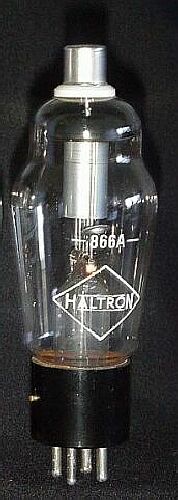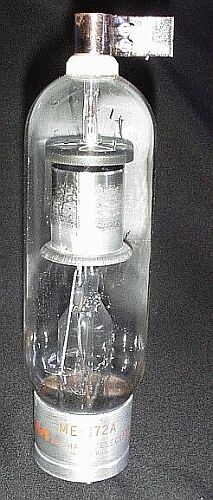 |
 |
 |
 |
They can handle considerably high voltages, the 866A being rated up to 3500 V at 250 mA - 1 A peak (the 872A 3500 V, 1.25 A - 5 A peak, the 869B up to 20 kV, 3 A!). Their main use was in transmitters, from amateur stations up to commercial ones. Due to some nasty drawbacks - the most serious being the constant danger of flashover at mains voltage spikes (backflashing, thus shorting the whole high-voltage supply...), they mostly were replaced as soon as possible by semiconductors. But if the high-voltage capabilities are not exploited to their limits (as they were in transmitters), they give very efficient, reliable and - nice looking ;-) rectifiers in larger HiFi-amplifiers, like big triode amps, who endlessly need anode power at 800-1000 Volts....
Their construction is very uniform: At top, there is a dish- or cup-shaped anode, connection is at the top of the tube. The lower, most dominant part of the system consists of a cylinder containing the large direct heated cathode. To provide enough emitting surface, it is often constructed from a quite tightly-woven mesh of thin nickel filaments, all coated with a thick oxide layer. To heat this large surface sufficiently, they need a lot of heating power - as shown above. This cylinder, connected to the cathode, acts as a shield for it, protecting it from the strong electric fields generated by the high operating voltages. Together with the cylinder, the shape of the plate forms a space with a very even electric field, the best insurance against flashover in all high-voltage devices.
So, we have a linear electrode system assembly here, the blueish arc burning freely within the room between the cathode cylinder and the plate. It is good visible from outside - contrary to the 83 tube, where it is almost totally enclosed within the coaxial electrode system. There are also some equivalent inert gas filled types: The DCX 4/1000 (eq. 866A) and DCX 4/5000 (eq. 872A) being the most common. Construction and operation are identical, arc colour is mostly purple.
Voltage drop in operation has the "typical mercury" values: between 10-20 Volts, 15 V for the 866A and 872A. If you like, you can also use them for "normal" plate voltages in the several 100-Volts range. Preheat time is about 30 seconds at room temperature, with very cold or longtime unused tubes allow at least 1 - 2 minutes, for sufficient mercury to vaporize. Heaters should be connected in parallel, if applicable - connecting them in series can only be recommended with tubes of identical brand and production line - the referring type value being heater voltage, not current.
For other pecularities and safety hints in operation of gaseous rectifiers, please see also page 83.htm.